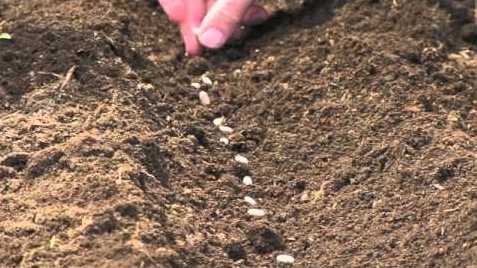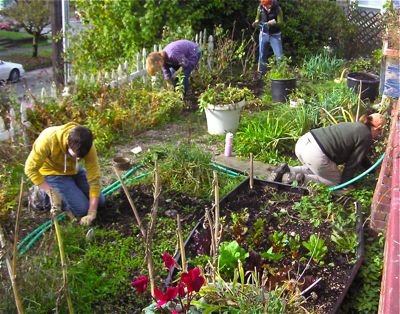 In the last few years millions of people taken their exercise outdoors during the summer, become novice gardeners and started growing their own food. Some plough up their lawns. Others invade parking strips. Churches too are transforming vacant lots and unused green spaces. Even the White House planted a vegetable garden to provide organic greens for the presidential dinners.
In the last few years millions of people taken their exercise outdoors during the summer, become novice gardeners and started growing their own food. Some plough up their lawns. Others invade parking strips. Churches too are transforming vacant lots and unused green spaces. Even the White House planted a vegetable garden to provide organic greens for the presidential dinners.
NOTE: Read all 4 pages of this article to get ideas and examples you can use.
For some this is a way to provide more healthy, locally grown organic food and develop healthy eating habits for their families. For others it is an opportunity to reach out to the marginalized by providing fresh produce to food banks and homeless shelters. For many it simply provides a chance to get outside and enjoy nature.
A common motivation for faith-centered community gardens is to respond to the opportunity to help those in need. Churches and small groups of Christians want to heal our earth or provide a beautiful green space for their congregations and neighbors to enjoy God’s good creation.
IMAGINE A CHURCH WITH A GARDEN IN THE FRONT YARD
 Unfortunately many so-called community gardens do not encourage community. Sometimes fences surround individual plots proclaiming in no uncertain terms – this is mine. Often the work for tending the plots falls to one or two people who zealously tend everyone else’s space. Sometimes the produce goes bad because people are too busy to harvest it.
Unfortunately many so-called community gardens do not encourage community. Sometimes fences surround individual plots proclaiming in no uncertain terms – this is mine. Often the work for tending the plots falls to one or two people who zealously tend everyone else’s space. Sometimes the produce goes bad because people are too busy to harvest it.
I believe one reason God created human beings to tend the garden [as seen in that original garden of Eden] is because God knew that in the midst of a garden we connect most intimately to the character and ways of God the Creator. Edythe Neumann who helped Highland Community Church in Abbotsford British Columbia establish a garden commented:
Gardening can teach us something about ourselves, about our interdependence with the world of nature, about the relationships between work and creativity, and about how we might begin to discern those spiritual facts that elude us in other aspects of life. Gardening can also be an expression of community and conversation – another way to say that God is with us on the earth, a way to picture God’s presence with us – through the gifts of nature and gardening together.
One church I know invited the congregation into the garden once a month after the morning service to help weed and tend the crops. Other churches recruit their youth groups and retirees as volunteers. Working together as a church community provides a wonderful sense of accomplishment and offers tremendous opportunity to strengthen intergenerational ties as young and old work side by side, weeding, watering and planting. You can even designate a special area as a children’s garden where children choose what grows and when it is harvested.
Church-based community gardens are great ways to reach out to our neighborhoods. Just by being out in the front yard, we can create a deeper sense of community with our neighbors. When a church plants “front and center” there is a greater ability to engage with neighbors. It makes a statement about the congregation’s concern for their community.
THE GARDEN – A PLACE TO EXERCISE, LEARN, AND GROW COMMUNITY
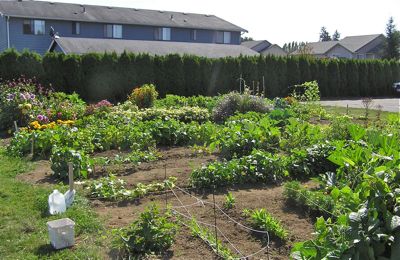 Sonlight Community Christian Reformed Church, in Lynden, Washington went door to door asking neighbors if they would like to participate. The Pumpkin Patch Community Garden at Millwood Presbyterian Church in Spokane, Washington used Facebook and Twitter to get the word out and had a Twitter inspired flash mob at there first big work day. Third Christian Reformed Church in Lynden partnered with AROCHA, to develop a show garden that grows new and different varieties, provide teaching to help establish other community gardens, and hand out food to neighbors. These examples help define what it means to do community gardening with God. They demonstrate that real community gardening is a tangible, engaging, more personal and enduring way for us to exercise our social life.
Sonlight Community Christian Reformed Church, in Lynden, Washington went door to door asking neighbors if they would like to participate. The Pumpkin Patch Community Garden at Millwood Presbyterian Church in Spokane, Washington used Facebook and Twitter to get the word out and had a Twitter inspired flash mob at there first big work day. Third Christian Reformed Church in Lynden partnered with AROCHA, to develop a show garden that grows new and different varieties, provide teaching to help establish other community gardens, and hand out food to neighbors. These examples help define what it means to do community gardening with God. They demonstrate that real community gardening is a tangible, engaging, more personal and enduring way for us to exercise our social life.
Many churches designate all or part of their harvest to local food banks. Grace Church in Old Saybrook, Connecticut gardens a quarter acre, which helped provide 908,000 meals in 2013 through the local Shoreline Soup Kitchens and Pantries. Other churches distribute the food amongst church members or invite neighbors to freely harvest from the garden encouraging a sense of community that goes far beyond the church congregation.
Community gardens can also form the basis for other church related activities. Classes in gardening, cooking and preserving, health and nutrition, healing the earth and other environmental issues and even spiritual formation can flow out of garden activities. My own venture into facilitating seminars on the spirituality of gardening grew out of constant prodding from friends who wanted to learn not just how to grow vegetables but also about how to connect their experiences to their faith.
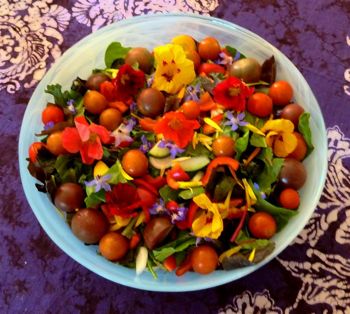 Montgomery Victory Gardens in Silver Spring MD offers great advice for churches contemplating community gardens:
Montgomery Victory Gardens in Silver Spring MD offers great advice for churches contemplating community gardens:
Start with a small group of committed individuals, but work hard to involve the entire congregation in some way.
Look for ways to make the process educational, and to make connections to your faith tradition.
Enlist people, especially young people from the community outside the congregation; start small and do realistic planning, especially when it comes to people’s crops in the beginning.
Keep a garden log and update the congregation throughout the process; expect surprises and have fun.
FAITH-CENTERED GARDENING – A DIRTY WORKOUT THAT TRANSFORMS YOU
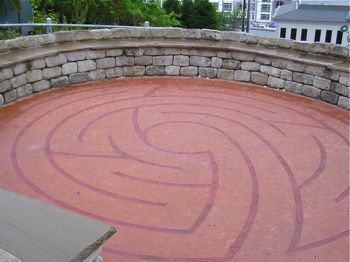 Incorporating sacred spaces into a garden is essential. Places to sit and meditate, prayer walks, community gathering spaces, even labyrinths can strengthen peoples’ faith beyond the activities associated with food production. Early monastic communities created walled gardens rich with biblical imagery. They often centered around an apple tree, representing both the Tree of Life in Genesis and the cross of Christ.
Incorporating sacred spaces into a garden is essential. Places to sit and meditate, prayer walks, community gathering spaces, even labyrinths can strengthen peoples’ faith beyond the activities associated with food production. Early monastic communities created walled gardens rich with biblical imagery. They often centered around an apple tree, representing both the Tree of Life in Genesis and the cross of Christ.
Connecting our garden experiences to our faith is important. In fact I am concerned that a faith-based community garden movement is not sustainable unless it is faith-centered and our gardening draws us closer to God. I often say that I read about the life, death and resurrection of Christ in the bible, but in the garden I experience it every time I bury a seed in the earth and watch it burst into life. I read about the generosity of God in the bible but in the garden I experience it every time I harvest my garden’s life giving bounty.
Share your abundance with others. Churches and community garden groups can share with the marginalized in gifts to food banks and community kitchens or with friends and neighbors in harvest celebrations. So, make sure that you plan at least one party this year where your garden produce has pride of place in the food on the table. It is a great way to culminate a summer season of vigorous outdoor physical fitness.
Faith-centered community gardens are not without their challenges. People are concerned about safety and liability issues, long term sustainability, who will weed and harvest, the provision for water and electricity, and more. Even what to do with the harvest can become a problem. All these details need to be discussed and planned for, which provides opportunity for a community to be strengthened as people work together creatively to find solutions.
Nothing can take away from the deep satisfaction of getting your hands into the earth, digging, planting and harvesting the bounty of God’s good creation. You’ll find gardening is great core training. Joy engulfs us as we experience the awe-inspiring generosity of a God who wants to provide abundantly for all of humankind.
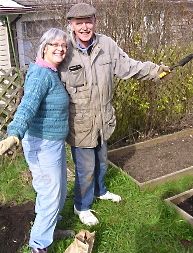 For me personally, the garden is a constant unfolding of new revelations about God. In the small intentional community where we live, we grow about 50% of our own vegetables. We invite non-residents to monthly garden days extending the feel of community to a broader circle. We also encourage kids to be involved. As an example when community member, Catie was seven years old, she was my best garden helper and practiced her newly developed writing skills making markers for our tomato seedlings.
For me personally, the garden is a constant unfolding of new revelations about God. In the small intentional community where we live, we grow about 50% of our own vegetables. We invite non-residents to monthly garden days extending the feel of community to a broader circle. We also encourage kids to be involved. As an example when community member, Catie was seven years old, she was my best garden helper and practiced her newly developed writing skills making markers for our tomato seedlings.
In the beginning God created a garden and invited us to share it with Him. He asked us to exercise our bodies and determination to steward its resources, and enjoy its delights with Him. This was truly a community garden, with God at the center. Imagine how our lives, our churches and our neighborhoods would be transformed if we once more accepted God’s invitation to join Him in the garden. As the examples above show, it is still in the garden that many of us find community and draw close to the living God. Working together, sharing produce with each other and reaching out to those at the margins with God’s generous excess invites us into the gospel story in new ways. How can we accept God’s invitation and find real community with God? We do it with each other and God’s good creation once more.
 Get your copy of To Garden With God by Christine Sine.
Get your copy of To Garden With God by Christine Sine.
Read more gardening articles in the Faith & Fitness Magazine Gardening Department.

